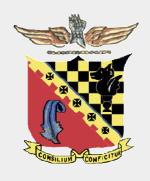Corgi US39914 USAAF P47D Thunderbolt, Lt. Warren Penny, 317th Fighter Squadron, 325th Fighter Group, March 1944, & P-51B Mustang, Capt. Robert Barkey, 319th Fighter Squadron, 325th Fighter Group, July 1944 "The Checkertail Clan" (1:72 Scale)
"Okay, let's go."
- Supreme Allied Commander Dwight D. Eisenhower on the eve of D-Day, June 5th, 1944
 No other aircraft of WWII could fly as high, go as far, or fight as hard as the famed Mustang. Piloted by a record 281 Aces, this agile and ferocious dogfighter tallied more kills than any other Allied airplane. As the bombers of the Eighth Air Force fought their way deep into Hitler's Germany, it was the Mustang that cleared the skies of Luftwaffe fighters. The powerful Rolls-Royce Merlin engine gave the Mustang a speed of 445 mph. Re-styled with an aerodynamic bubble canopy for greater visibility, and outfitted with 6 fast-firing .50 caliber machine guns, the P-51 became the best fighter of the war.
No other aircraft of WWII could fly as high, go as far, or fight as hard as the famed Mustang. Piloted by a record 281 Aces, this agile and ferocious dogfighter tallied more kills than any other Allied airplane. As the bombers of the Eighth Air Force fought their way deep into Hitler's Germany, it was the Mustang that cleared the skies of Luftwaffe fighters. The powerful Rolls-Royce Merlin engine gave the Mustang a speed of 445 mph. Re-styled with an aerodynamic bubble canopy for greater visibility, and outfitted with 6 fast-firing .50 caliber machine guns, the P-51 became the best fighter of the war.
Nicknamed the "Jug" for its bulky shape, the Republic P-47 Thunderbolt was considered a monster of a machine. Despite its size, the Thunderbolt proved to be a fast and maneuverable warbird able to hold its own in combat. In fact, when Allied pilots climbed aboard a P-47, they knew the were in control of a fighting machine with enormous power. More importantly, they knew that if their aircraft was hit but gunfire, they had an excellent chance of making it home.
Pictured here are a pair of 1:72 scale "Checkertail Clan" aircraft: a USAAF P47D Thunderbolt piloted by Lt. Warren Penny of the 317th Fighter Squadron, 325th Fighter Group, and a P-51B Mustang flown by Capt. Robert Barkey of the 319th Fighter Squadron, 325th Fighter Group.
Sold Out!
Dimensions:
P-51 Mustang
Wingspan: 6-3/4-inches
Length: 5-inches
Dimensions:
P-47 Thunderbolt
Wingspan: 6-3/4-inches
Length: 6-inches
Release Date: October 2009
 Historical Account: "The Checkertail Clan" - The 325th trained in the U.S. with P-40 aircraft before moving to North Africa by ship and transport planes, January-February 1943. It entered combat in April 1943 and began escorting medium bombers, flying strafing missions, and conducting sea sweeps from bases in Algeria and Tunisia. The group participated in the defeat of Axis forces in Tunisia, the reduction of Pantelleria, and the conquest of Sicily. The 325th received a Distinguished Unit Citation (DUC) for action over Sardinia on July 30th, 1943 when the group, using diversionary tactics, forced a superior number of enemy planes into the air and destroyed more than half of them. The group did not fly combat missions from the end of September to mid-December 1943 as the group converted to P-47 aircraft and moved to Italy.
Historical Account: "The Checkertail Clan" - The 325th trained in the U.S. with P-40 aircraft before moving to North Africa by ship and transport planes, January-February 1943. It entered combat in April 1943 and began escorting medium bombers, flying strafing missions, and conducting sea sweeps from bases in Algeria and Tunisia. The group participated in the defeat of Axis forces in Tunisia, the reduction of Pantelleria, and the conquest of Sicily. The 325th received a Distinguished Unit Citation (DUC) for action over Sardinia on July 30th, 1943 when the group, using diversionary tactics, forced a superior number of enemy planes into the air and destroyed more than half of them. The group did not fly combat missions from the end of September to mid-December 1943 as the group converted to P-47 aircraft and moved to Italy.
The 325th began operations with Fifteenth Air Force in December 1943, and primarily engaged in escort operations. It received a second DUC for a mission on January 30th, 1944 when the group flew more than 300 miles at very low altitude to surprise the enemy fighters that were defending German airdromes near Villaorba, Italy; by severely damaging the enemy's force, the 325th enabled heavy bombers to strike vital targets in the area without encountering serious opposition. The group converted to P-51 aircraft in May 1944 and provided the fighter escort on the first shuttle bombing mission from Italy to Russia in early June 1944. It escorted heavy bombers during long-range missions to attack the Messerschmitt factory at Regensburg, the Daimler-Benz tank factory at Berlin, oil refineries at Vienna, and other targets, such as airfields, marshaling yards, and communications targets in Italy, France, Germany, Czechoslovakia, Austria, Hungary, Romania, and Yugoslavia. It also covered operations of reconnaissance aircraft and strafed such targets as trains, vehicles, and airfields. The group continued combat operations until May 1945. The group moved back to the U.S. and was deactivated after V-E Day.


